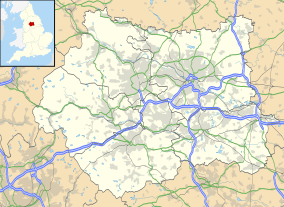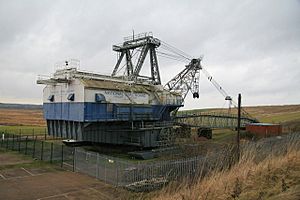St Aidan's facts for kids
Quick facts for kids RSPB St Aidan's |
|
|---|---|
| Location | West Yorkshire, England |
| Established | 2017 |
| Operator | Royal Society for the Protection of Birds |
St Aidan's is a huge nature park in West Yorkshire, England. It's about 400 hectares in size, which is like 400 football fields! This amazing place is located between the cities of Leeds and Castleford.
Before it became a nature park, St Aidan's was a massive opencast coal mining area. This means coal was dug up from the surface of the ground. In 1988, a big flood happened when the riverbank collapsed. Fixing the area was such a huge job that a special law had to be passed in Parliament to allow the work to go ahead. Mining at St Aidan's finally stopped in 2002.
The nature park first opened to the public in May 2013. It was looked after by the Royal Society for the Protection of Birds (RSPB). However, the car park and visitor centre had to close in July 2013. This was because of some problems with who owned the land.
But don't worry! Everything was sorted out. In March 2017, Leeds City Council took over ownership. They then signed a 99-year lease with the RSPB. This means the RSPB will manage the park for a very long time. St Aidan's is now fully open and working as a wonderful RSPB nature park. It's open every day except Christmas Day. The visitor centre welcomes people from 9:30 am to 5 pm between February and October. In the winter months, from November to January, it closes a bit earlier at 4 pm.
RSPB St Aidan's Nature Park is a fantastic place for both people and wildlife. You can enjoy many activities here. These include bird watching, cycling, walking, jogging, horse riding, and even dog walking.
Contents
The Park's Past
St Aidan's nature park includes areas that were once part of the St Aidan's opencast site. It also covers parts of the Lowther North opencast site and the old Savile Colliery near Methley.
The Great Flood of 1988
In March 1988, something dramatic happened. A part of the River Aire bank broke, causing a massive flood. About 17 million litres of water poured into the mine workings! That's enough water to fill many swimming pools. RAF Chinook helicopters were even used to fly in sandbags. But it wasn't enough to stop the water. It took four days for the mine to completely fill up.
Not only did the River Aire flow into the site, but the River Calder actually flowed backwards from Castleford! This happened until the water found a natural level. The flood created a huge lake, about 100 hectares in size and 70 metres deep. That's as deep as a 20-story building!
Fixing the Mine
Because of the flood, mining had to stop. It cost £20 million to drain the site and change the path of the river. After ten years, mining started again and was eventually finished. Then, the site was turned into a beautiful wetland nature reserve.
Discoveries from the Past
When the river was moved, an old riverbed was uncovered. The Pontefract and District Archaeological Society found some amazing things there. They discovered the nearly complete hulls of four old boats! They also found pottery and signs of a medieval weir (a small dam). These finds gave a special look into how people traded on the river from the 1600s onwards. The society even won an award for their important work.
Who Owns the Park?
In 2010, the land was given to the St Aidan's Trust. This is a charity managed by Leeds City Council. The trust then agreed to lease the land to the RSPB for 99 years. This was for a very small "peppercorn rent," which means almost free!
The park officially opened on May 25, 2013. But, as mentioned, it closed briefly due to land ownership issues. Finally, on December 21, 2016, the ownership was fully transferred to the St Aidan's Trust. The RSPB then signed their 99-year lease and the park reopened in April 2017. Now, the RSPB is in charge of everything, including the car park, visitor centre, and all visitor activities.
Where is St Aidan's?
St Aidan's is right next to the River Aire and the Aire and Calder Navigation. You can get to the nature park using many paths. Some of these paths run right along the River Aire. The park is also about 2 miles from Woodlesford railway station.
Nearby towns and villages include Allerton Bywater, Mickletown, Methley, Woodlesford, Swillington, and Great Preston. This whole area is surrounded by three major motorways: the A1(M), the M62, and the M1.
Amazing Wildlife
The main trails at St Aidan's take you through many different natural areas. You'll see reedbeds, wetlands, meadows, and woodlands. These different habitats are home to many types of birds.
Birds of St Aidan's
St Aidan's is a fantastic place for birdwatching. You might spot birds like the Eurasian bittern, little owl, western marsh harrier, and Eurasian skylark.
Some very special birds also breed here. One of the rarest in the UK is the black-necked grebe. About 25% of all black-necked grebes in the country nest at St Aidan's! They often nest close to the one thousand pairs of black-headed gulls for protection. Other breeding birds include the northern lapwing and the common redshank.
Meet Oddball the Dragline
At St Aidan's, you can see a giant and unique "walking" dragline called Oddball. A dragline is a huge machine used in mining to dig up earth. It's called Oddball because it was built in the US to run on a different electrical system than the UK.
Oddball was first named Clinchfield. It came to the UK from the US in 1954. At that time, it was the second-largest machine of its kind in the world! It weighed a massive 1,220 tonnes. Oddball moved to St Aidan's in 1974. It was used to dig up coal from the area that is now the nature park.
This giant machine could move at a maximum speed of only 0.3 kilometres per hour. It moved in steps, about 2 metres at a time. Oddball last moved in 1999. It was moved to the top of a hill overlooking the reserve to be preserved. The group Friends of St Aidan's BE1150 Dragline says it's the largest preserved walking dragline excavator in Western Europe. They hold open days throughout the year. Visitors can look around the machine and even sit in the cab!



